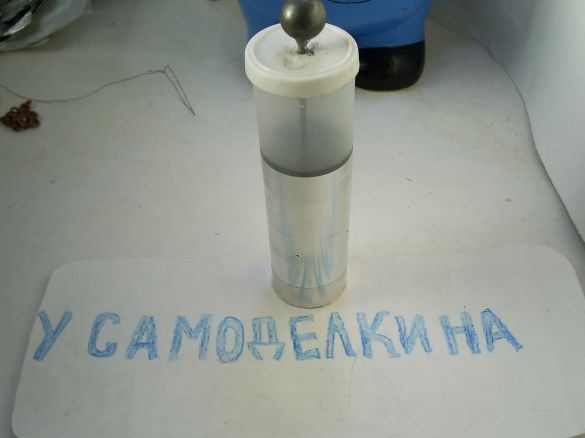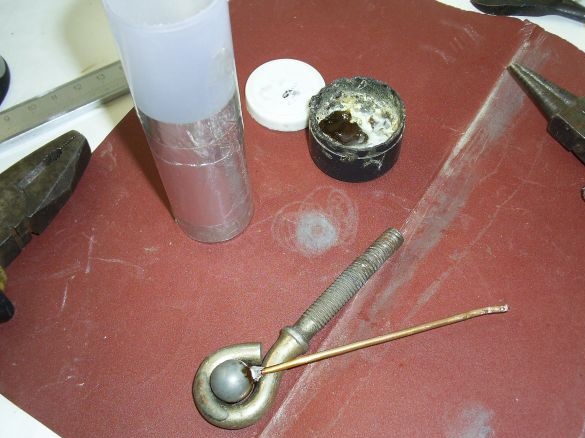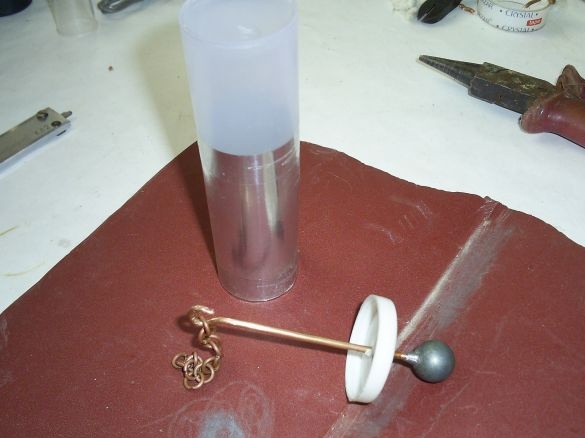Hello. I would like to show how a Leiden jar or the simplest capacitor is made.
But first, a little information for those who don’t know what it is, but those who are in the know can skip or read in order to refresh the memory.
Leiden Jar is the first electric capacitor invented by the Dutch scientist Peter Van Mushenbrook and his student Küneus in 1745 in Leiden. In parallel and independently, a similar apparatus called the “medical jar” was invented by the German scientist Ewald Jürgen von Kleist.
This old device can accumulate static electricity, which attracted me.
It consists of a capacitance (banks) wrapped in foil from the outside and internal foil glued with the same foil itself, two-thirds of the height, they will be the plates of our capacitor, and the capacitance (by the way, must not pass electricity) will be the dielectric between them.
From the tools I needed:
1) Scissors.
2) Awl.
3) Pliers.
4) Soldering iron.
From materials:
1) capacity.
2) Foil.
3) A piece of copper wire.
4) Scotch tape.
5) Ball from the bearing.
So. As a basis, I took the tank from the end of cold welding. At first I wanted from a glass jar, but they were all thick-walled and large.
I cut a piece of foil for the bottom (to increase the usable area and thereby increase productivity).
Following that, I wrapped the foil outside the wall of my container, tried to make the foil fit as tightly as possible, because this also affects how much charge it will accumulate.
By the way, in the first Leyden bank this foil was successfully replaced by the hand of the scientist Muschenbruck (Mushenbrek) (1692-1761), who was clutching a vessel and realized that it was better not to touch the wire that was connected to the electrostatic machine that charged the Leyden jar.
Searching in the bins, I found a ball from the bearing, it’s a pity, of course, that no larger diameter was found, but it also collects static electricity well.
I decided to fix it by soldering. To begin with, I cleaned the place of soldering with sandpaper.
Then he half-rosin and soldered the copper wire with a ball.
Then he just pierced the lid of the container with an awl and put a wire with a ball there.
The bottom photo shows the chain that I put in contact with the inner lining, but subsequently abandoning the foil (due to the lack of glue or foil tape), which was inside and replacing the foil with water, it was dismantled.
And here he is in the equipped form.
I do not have an electrostatic machine to check.
I had to charge it using a TV (zomboyaschik). Having climbed two or three times around the screen with a ball, he collected enough electric charges to discharge the spark.
And it’s beating, I’ll tell you, it’s not sickly, stronger than the lighter piezoelectric element.
Of course, I didn’t want to repeat the experience of Peter Van Mushenbrook, but I had to because of my sloppiness and easily distracted.
For those who want to make a Leyden jar with their own hands and do not know how to do this, I can say the following:
The vessel may be glass. For a small Leyden jar, it is better if the walls are thinner.
Instead of foil, it is more convenient to use foil tape and make sure that air bubbles do not remain between the tape and the vessel.
If you decide to glue the inner side of the can with foil tape, you must make sure that the wire with the ball touches the inner lining (you can solder the stranded wire and make a brush or type of spring from a single-core wire, in general, there are a lot of options). And if with water, then the wire must necessarily touch the water.
A ball can be made of any material even a dielectric, but it will also need to be covered with foil (and so that the foil touches the wire), if you want, you can simply roll the ball out of foil faster.
You can even charge it with a comb, pen, etc. only it is ineffective it is better if there is no electrophore machine, charge from the TV screen (only those with a cathode ray tube are suitable).
And finally, I would like to recall the safety technique itself, because this is the main thing. Do not repeat my mistake, be vigilant. Of course, you will not die from the accumulated charge of a small Leyden jar (it depends on many factors, including your state of health), but if you make it large and connect it to an electrophore machine, it is quite possible. It is thanks to the Leyden banks that the electrophore machine develops its power and emits such long frightening (some) sparks, since the collected electric charge accumulates in the banks ...










